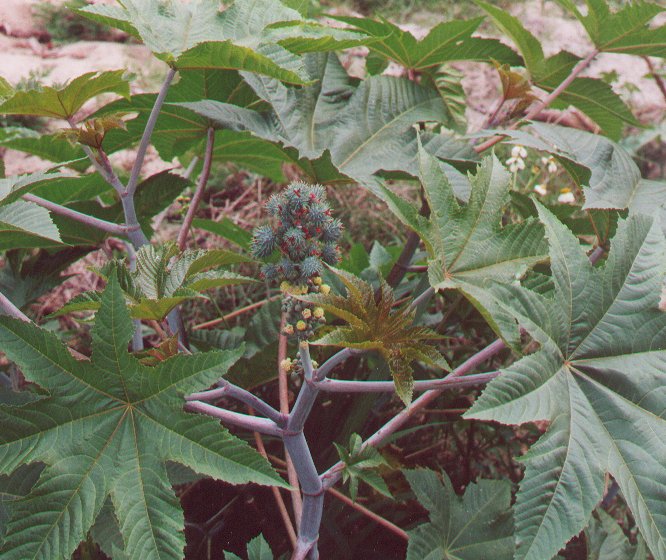Ricinus communis L.
Castor Oil Plant

Introduced
CC = *
CW = 3
MOC = 6
© DETenaglia
Ricinus communis L.Castor Oil Plant | |
 |
Introduced CC = * CW = 3 MOC = 6 |
© DETenaglia |
|
Family - Euphorbiaceae Stems - To 5m tall, glabrous, glaucous, suffrutescent (with age) or entirely herbaceous, branching, reddish, greenish, or purplish. Leaves - Alternate, peltate, long petiolate, palmately 5 to 7 lobed, toothed, glabrous, to +30cm broad.
Inflorescence - Axillary racemes or loose panicles to +50cm tall, on thick peduncle.
Staminate flowers - At base or lower portion of inflorescence, apetalous, pedicillate. Calyx typically 5-parted, reflexed. Stamens many, the filaments branching. Anthers yellow.
Pistillate flowers - Capsules red, green or purple, covered with dense spines, +1.5cm in diameter, 3-seeded. Seeds mottled with copper, black, and bronze colors. Styles 3, red.
Flowering - August - November. Habitat - Mostly cultivated. Also escaped to roadsides, railroads, waste ground, disturbed sites. Origin - Native to Asia. Other info. - This plant is the source of castor beans (used in ornamentation) and castor oil(pressed from the seeds). The plant is also more toxic than any other plant to humans. The seed cake which is left over after pressing contains a protein toxin known as Ricin which replaces a vital enzyme in cellular metabolism causing the shutdown of protein synthesis in the body. No protein - no life. The toxin contains an alpha section, which causes the cell shutdown, and a beta section which carries the molecule across the cell membrane. Red variety photos taken at Powell Gardens, 9-2-99. Typical species photos taken off Cypress Gardens Blvd., Winter Haven, FL., 3-26-00. |